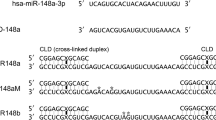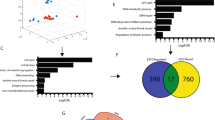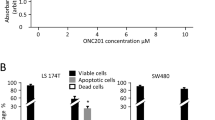Abstract
G3139 is a phosphorothioate oligodeoxyribonucleotide that is targeted to the initiation codon region of the Bcl-2 mRNA, which downregulates Bcl-2 protein and mRNA expression via an antisense mechanism. In previous work, we have demonstrated that the phenotype observed in several prostate and melanoma cell lines after treatment with G3139 appears to be Bcl-2 independent. In contrast, downregulation of Bcl-2 expression by a small interfering RNA (siRNA) produced little or no phenotype change. In the present work, we performed an Agilent oligonucleotide microarray assay on mRNA isolated from PC3 prostate cancer cells that were treated with two different oligonucleotide gene-silencing reagents. G3139 and a Bcl-2-targeting siRNA both downregulate Bcl-2 expression, but via different mechanisms. A side-by-side comparative analysis showed that the expression profile generated by these molecules differs substantially. The study revealed upregulation of the expression of stress-inducible genes in PC3 cells at 1 and 3 days after a 5-h transfection with G3139 complexed with Lipofectamine 2000. In contrast, only a very diminished stress response was seen 1 and 3 days after a 24-h transfection of siRNA/Lipofectamine 2000 complexes. These results highlight the profound differences in off-target effects in cells treated with the phosphorothioate oligonucleotide G3139 and with an siRNA targeted to the same gene, and provide further evidence that the mechanism of action of G3139 is not related to Bcl-2 silencing.
This is a preview of subscription content, access via your institution
Access options
Subscribe to this journal
Receive 12 print issues and online access
$259.00 per year
only $21.58 per issue
Buy this article
- Purchase on Springer Link
- Instant access to full article PDF
Prices may be subject to local taxes which are calculated during checkout



Similar content being viewed by others
Accession codes
Accessions
GenBank/EMBL/DDBJ
References
Klasa R, Gillum A, Klem R, Frankel S . Oblimersen Bcl-2 antisense: facilitating apoptosis in anticancer treatment. Antisense Nucleic Acid Drug Dev 2002; 12: 193–213.
Miyashita T, Reed J . Bcl-2 oncoprotein blocks chemotherapy-induced apoptosis in a human leukemia cell line. Blood 1993; 81: 151–157.
Kamesaki S, Kamesaki H, Jorgensen T, Tanizawa A, Pommier Y, Cossman J . Bcl-2 protein inhibits etoposide-induced apoptosis through its effects on events subsequent to topoisomerase II-induced DNA strand breaks and their repair (published erratum appears in Cancer Res 1994; 54: 3074). Cancer Res 1993; 53: 4251–4256.
Teixeira C, Reed J, Pratt M . Estrogen promotes chemotherapeutic drug resistance by a mechanism involving Bcl-2 proto-oncogene expression in human breast cancer cells. Cancer Res 1995; 55: 3902–3907.
Liston P, Fong WG, Korneluk R . Inhibitors of apoptosis: there is more to life than Bcl-2. Oncogene 2003; 22: 8568–8580.
Raffo A, Lai JC, Stein CA, Miller P, Scaringe S, Khvorova A et al. Antisense RNA down-regulation of Bcl-2 expression in DU145 prostate cancer cells does not diminish the cytostatic effects of G3139 (Oblimersen). Clin Cancer Res 2004; 10: 3195–3206.
Lai JC, Benimetskaya L, Santella RM, Wang Q, Miller PS, Stein CA . G3139 (Oblimersen) may inhibit prostate cancer cell growth in a partially bis-CpG-dependent non-manner. Mol Cancer Ther 2003; 2: 1031–1043.
Reynolds A, Leake D, Scaringe S, Marshall WS, Boese Q, Khvorova A . Rational siRNA design for RNA interference. Nat Biotechnol 2004; 22: 326–330.
Gleave M, Tolcher A, Miyake H, Nelson C, Brown B, Beraldi E et al. Progression to androgen independence is delayed by adjuvant treatment with antisense Bcl-2 oligodeoxynucleotides after castration in the LNCaP prostate tumor model. Clin Cancer Res 1999; 5: 2891–2898.
Benimetskaya L, Wittenberger T, Stein CA, Hofmann H-P, Weller C, Lai JC et al. Changes in gene expression induced by phosphorothioate oligodeoxynucleotides (including G3139) in PC3 prostate carcinoma cells are recapitulated at least in part by treatment with interferon-beta and -gamma. Clin Cancer Res 2004; 10: 3678–3688.
Owa T, Yokoi A, Yamazaki K, Yoshimatsu K, Yamori T, Nagasu T . Array-based structure and gene expression relationship study of antitumor sulfonamides including N-[2-[(4-hydroxyphenyl)amino]-3-pyridinyl]-4-methoxybenzenesulfonamide and N-(3-chloro-7-indolyl)-1,4-benzenedisulfonamide. J Med Chem 2002; 45: 4913–4922.
Li J, Wang F, Protopopov A, Malyukova A, Kashuba V, Minna J et al. Inactivation of RASSF1C during in vivo tumor growth identifies it as a tumor suppressor gene. Oncogene 2004; 23: 5941–5949.
Hultquist A, Cetinkaya C, Wu S, Castell A, Erlandsson A, Larsson L-G . MAD inhibits cell growth and proliferation but does not promote differentiation or overall survival in human U-937 monoblasts. Mol Cancer Res 2004; 2: 464–476.
Inoue K, Roussel MF, Sherr CJ . Induction of ARF tumor suppressor gene expression and cell cycle arrest by transcription factor DMP1. Proc Natl Acad Sci USA 1999; 96: 3993–3998.
Jabbour L, Welter J, Kollar J, Hering T . Sequence, gene structure, and expression pattern of CTNNBL1, a minor-class intron-containing gene – evidence for a role in apoptosis. Genomics 2003; 81: 292–303.
Krieg A . CpG motifs in bacterial DNA and their immune effects. Annu Rev Immunol 2002; 20: 709–760.
Author information
Authors and Affiliations
Corresponding author
Additional information
Supplementary Information accompanies the paper on Cancer Gene Therapy website (http://www.nature.com/cgt).
Supplementary information
Rights and permissions
About this article
Cite this article
Anderson, E., Miller, P., Ilsley, D. et al. Gene profiling study of G3139- and Bcl-2-targeting siRNAs identifies a unique G3139 molecular signature. Cancer Gene Ther 13, 406–414 (2006). https://doi.org/10.1038/sj.cgt.7700901
Received:
Revised:
Accepted:
Published:
Issue Date:
DOI: https://doi.org/10.1038/sj.cgt.7700901
Keywords
This article is cited by
-
Noncoding RNA therapeutics — challenges and potential solutions
Nature Reviews Drug Discovery (2021)
-
Non-coding RNAs as drug targets
Nature Reviews Drug Discovery (2017)
-
Deletion of murine Arv1 results in a lean phenotype with increased energy expenditure
Nutrition & Diabetes (2015)
-
Curcumin reduces expression of Bcl-2, leading to apoptosis in daunorubicin-insensitive CD34+ acute myeloid leukemia cell lines and primary sorted CD34+ acute myeloid leukemia cells
Journal of Translational Medicine (2011)
-
2′-O-Lysylaminohexyladenosine modified oligonucleotides
Monatshefte für Chemie - Chemical Monthly (2010)



